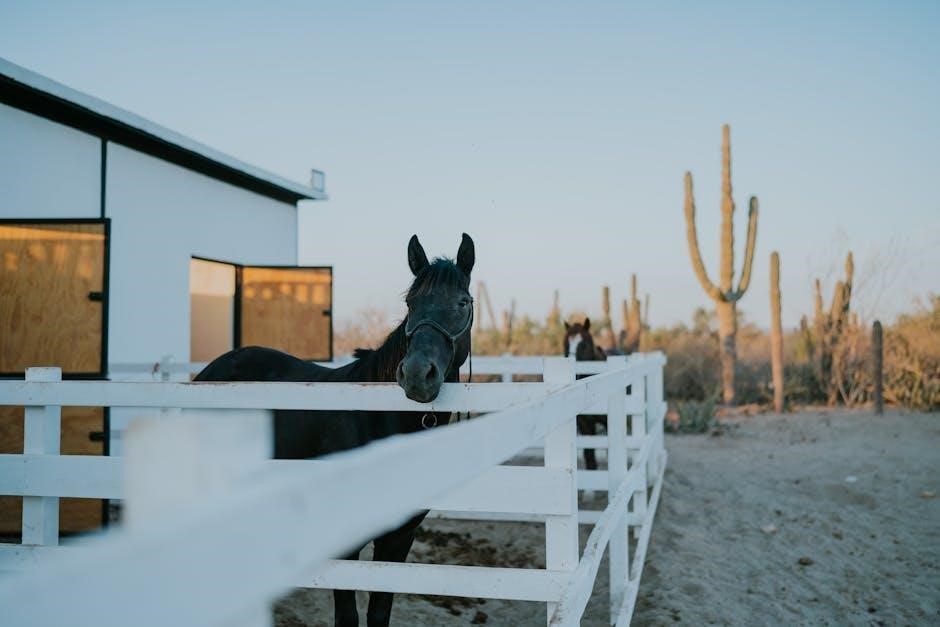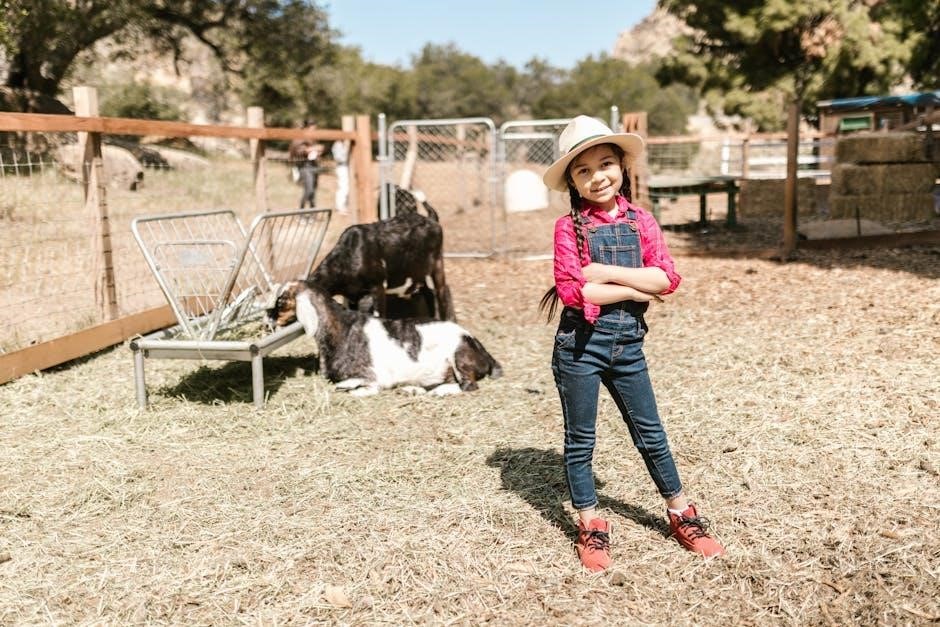Farm fence post spacing is crucial for structural integrity and livestock containment․ Proper spacing ensures durability‚ safety‚ and cost-efficiency‚ varying based on terrain‚ livestock‚ and fence type․
1․1 Importance of Proper Spacing in Farm Fencing
Proper farm fence post spacing is essential to ensure structural integrity‚ prevent sagging‚ and maintain fence durability․ It safeguards livestock by minimizing escape risks and reduces maintenance needs over time․ Correct spacing also optimizes material costs and ensures the fence withstands environmental stresses․ Adequate post spacing varies by terrain‚ livestock type‚ and fence purpose‚ making it a critical factor for long-term efficiency and safety․
1․2 Overview of Key Factors Influencing Post Spacing
Post spacing in farm fencing is influenced by several factors‚ including the type of livestock‚ fence purpose‚ and terrain conditions․ Livestock behavior and size determine spacing needs‚ while fence type‚ such as barbed wire or woven wire‚ affects post intervals․ Terrain challenges like slopes or uneven ground also impact spacing decisions․ Understanding these factors ensures effective and efficient fence installation‚ balancing both functionality and cost․
Factors Influencing Farm Fence Post Spacing
Livestock type‚ fence purpose‚ and terrain are key factors influencing post spacing․ These elements determine the structural needs and durability of the fencing system․
2․1 Type of Livestock and Their Fencing Needs
The type of livestock significantly impacts fence post spacing․ For cattle‚ posts are typically spaced 10-12 feet apart‚ while smaller animals like poultry may require closer spacing․ Horse fencing often demands wider spacing but stronger materials․ The behavior and size of the animals determine the necessary post intervals to ensure containment and prevent escape or injury․
2․2 Type of Fence and Its Purpose
The purpose and type of fence dictate post spacing․ Barbed wire fences often have posts spaced 10-12 feet apart‚ while woven wire fences may require closer intervals for durability․ Electric fencing allows for wider spacing due to its deterrent effect․ The primary function‚ whether for containment‚ boundary marking‚ or protection‚ influences the optimal post placement to achieve the desired effectiveness and longevity of the fence․
2․3 Terrain and Landscape Conditions
Terrain and landscape significantly influence post spacing․ On flat ground‚ wider intervals are possible‚ while hilly or uneven land requires closer posts for stability․ Areas with heavy tree coverage or rocky terrain may need adjusted spacing to accommodate obstacles․ Seasonal soil changes‚ such as frost heave‚ also affect post stability‚ necessitating careful planning to maintain fence integrity across varying conditions․
Traditional Farm Fence Post Spacing Methods
Traditional methods include barbed wire‚ woven wire‚ and electric fencing‚ each with specific spacing standards․ Barbed wire typically uses posts spaced 10-12 feet apart‚ while woven wire may require closer intervals for smaller livestock․ Electric fencing offers flexibility but often follows similar spacing guidelines based on terrain and purpose․
3․1 Barbed Wire Fencing Post Spacing
Barbed wire fencing typically uses posts spaced between 10 to 12 feet apart‚ depending on the number of strands and the type of livestock․ This method is cost-effective and durable‚ commonly used for cattle․ The standard setup includes three to five strands of wire‚ with posts driven into the ground at regular intervals to maintain tension and prevent sagging․ This spacing ensures security and minimizes maintenance needs․
3․2 Woven Wire Fencing Post Spacing
Woven wire fencing typically requires posts spaced 8 to 12 feet apart‚ depending on the wire mesh size and livestock type․ Tighter spacing is recommended for smaller animals to prevent escape‚ while larger livestock may allow wider gaps․ This method ensures durability and security‚ making it ideal for long-term fencing solutions․ Proper spacing maintains the fence’s structural integrity and prevents sagging or damage over time․
3․3 Electric Fencing Post Spacing
Electric fencing post spacing typically ranges from 10 to 15 feet apart‚ depending on terrain and livestock type․ Tighter spacing is preferred for hilly or uneven land to maintain wire tension․ For portable electric netting‚ closer spacing (5-7 feet) ensures better control over small animals like poultry․ Always follow manufacturer guidelines for specific systems to optimize performance and animal safety․
Choosing the Right Materials for Farm Fencing
Selecting durable materials is vital for a long-lasting fence․ Options include wood‚ metal‚ or composite posts‚ paired with barbed wire‚ woven wire‚ or electric fencing for optimal performance․
4․1 Selecting the Best Posts for Your Fence
Choosing the right fence posts is essential for durability and stability․ Wood posts are traditional and cost-effective‚ while metal posts offer strength and longevity․ Consider factors like soil type‚ moisture levels‚ and local climate when deciding․ Treated wood or galvanized metal posts are ideal for withstanding harsh conditions․ Ensure posts are tall enough to support the fence height and securely anchored in the ground for maximum stability and performance over time․ Proper selection prevents premature rotting or rusting‚ ensuring a long-lasting fence that requires minimal maintenance․ Always assess the specific needs of your farm and livestock to make an informed decision that balances cost and durability․ Additionally‚ consider the ease of installation and availability of materials in your area to simplify the process and ensure timely completion․ By selecting high-quality posts‚ you lay a solid foundation for a reliable and efficient fencing system that protects your livestock and property effectively․
4․2 Choosing the Right Wire or Rail for Your Fence
Selecting the appropriate wire or rail depends on your fencing purpose and livestock needs․ Barbed wire is durable and cost-effective for cattle‚ while woven wire suits smaller animals․ Electric fencing offers portability and versatility․ High-tensile wire provides long-lasting strength‚ ideal for large pastures․ Consider factors like animal size‚ behavior‚ and local regulations when deciding․ The right wire or rail ensures safety‚ containment‚ and minimal maintenance‚ tailored to your farm’s specific requirements and budget constraints․
Tools and Equipment Needed for Proper Post Spacing
Essential tools include a tape measure‚ stakes‚ twine‚ shovel‚ and post-hole digger․ Additional items like a tamping tool ensure secure and level post installation‚ preventing future shifting․
5․1 Essential Tools for Measuring and Marking Post Locations
A sturdy tape measure is vital for accurate post spacing․ Use wooden stakes and twine to mark post positions․ A spirit level ensures straight alignment‚ while a compass helps navigate uneven terrain․ FLAGS or spray paint can temporarily mark spots․ For precise corners‚ consider using a laser level or string grid system to maintain consistency across the fencing area․
5․2 Tools for Digging and Setting Posts
A shovel or post-hole digger is essential for creating holes․ For deeper holes‚ a power auger can save time․ Concrete or quick-set mix strengthens post stability․ Use a tamping tool to firmly pack soil around posts․ Safety gloves and a level ensure secure and straight installation․ These tools help achieve proper alignment and durability for your farm fence‚ ensuring long-lasting structural integrity and effectiveness․

Best Practices for Installing Farm Fence Posts
Ensure accurate measurements and alignment․ Use a post-hole digger for precise digging․ Secure posts with concrete for stability․ Tamper soil firmly around posts to prevent shifting over time․
6․1 Measuring and Marking Post Locations Accurately
Accurate measurement is key to proper post spacing․ Use a tape measure to mark post locations‚ ensuring consistency․ Stake and twine can help visualize the layout․ Double-check measurements to avoid errors‚ as misaligned posts can lead to structural issues․ Proper alignment ensures even spacing‚ preventing leaning or uneven fencing․ This step is foundational for a durable and efficient farm fence․ Always verify measurements before digging to save time and materials․
6․2 Ensuring Proper Alignment and Leveling
Proper alignment and leveling are essential for a stable fence․ Use a spirit level to ensure posts are straight and a string line for consistent alignment․ Uneven terrain may require adjusting post depths․ Regularly check the alignment as you install posts to maintain a straight fence line․ This ensures the fence remains secure and visually appealing‚ preventing future structural issues․ Proper leveling also helps distribute weight evenly across the fence․
6․3 Tips for Securing Posts in the Ground
Securing posts firmly in the ground ensures fence stability․ Dig holes 12-18 inches deep‚ depending on post height․ Use concrete for permanent installations or compact soil for temporary․ Tamping ensures even support․ Consider adding gravel for drainage․ Tightening wires or rails after installation prevents shifting․ Regular inspections help maintain post stability‚ especially in changing soil conditions․ Proper securing prevents leaning or loosening over time․ This ensures long-lasting fence performance․
Maintenance and Adjustment of Farm Fence Posts
Regularly inspect posts for stability and damage․ Adjustments may be needed due to seasonal soil shifts․ Ensure posts remain secure to maintain fence integrity and longevity effectively․
7․1 Regular Inspection of Post Stability
Regular inspection of post stability is essential to ensure fence durability․ Check for leaning or loose posts‚ especially after extreme weather․ Addressing issues promptly prevents costly repairs and maintains fence effectiveness․ Seasonal soil changes can affect post alignment‚ so monitoring and adjusting posts annually is recommended․ Secure any unstable posts to uphold structural integrity and safety․
7․2 Adjustments for Seasonal Soil Changes
Seasonal soil changes can impact post stability‚ requiring periodic adjustments․ During winter‚ soil expansion may loosen posts‚ while summer contraction can tighten them․ Monitor posts after extreme weather and adjust as needed․ Tightening wires or resetting posts ensures continued structural integrity․ Regular checks and minor corrections prevent major repairs‚ maintaining fence effectiveness and longevity․ Soil shifts are inevitable‚ but proactive adjustments mitigate their effects․

Advanced Techniques for Farm Fence Post Spacing
Advanced techniques include using portable electric netting for livestock and reinforcing posts at corners and gates for added stability and durability in challenging conditions․
8․1 Using Electric Fence Netting for Portability
Electric fence netting offers versatility and portability‚ ideal for temporary fencing needs; It allows easy setup and relocation‚ making it perfect for rotational grazing or managing different livestock areas․ Posts can be spaced farther apart‚ reducing material costs while maintaining effectiveness․ Lightweight designs enable quick installation without compromising security‚ ensuring efficient livestock control and adaptability to varying terrains and conditions․
8․2 Reinforcing Posts at Corners and Gates
Reinforcing posts at corners and gates is essential for withstanding stress and ensuring long-term stability․ Use larger‚ heavier-duty posts or add concrete footings for added strength․ Diagonal bracing between corner posts can prevent sagging and maintain structural integrity․ This extra reinforcement ensures the fence remains secure‚ especially in high-stress areas‚ enhancing overall durability and safety for livestock and equipment․
Proper farm fence post spacing ensures structural integrity and efficiency․ Understanding terrain‚ livestock needs‚ and materials is vital․ Balancing aesthetics with functionality ensures long-lasting results․
9․1 Summary of Key Takeaways
Effective farm fence post spacing balances durability‚ cost‚ and functionality․ Livestock type‚ terrain‚ and fence purpose dictate optimal spacing․ Regular inspections and adjustments ensure longevity․ Choosing the right materials enhances performance․ Proper installation techniques are essential․ Seasonal soil changes may require post adjustments․ Reinforcing corners and gates adds strength․ Considering these factors ensures a safe and efficient fencing system for years to come․
9․2 Final Tips for a Durable and Efficient Farm Fence
For a durable and efficient farm fence‚ prioritize high-quality materials and proper installation․ Regularly inspect posts and wires for damage or wear․ Adapt spacing to terrain and livestock needs․ Consider portable options like electric netting for flexibility․ Ensure posts are deeply anchored and aligned correctly․ Maintain consistent tension in wires or rails․ Plan for seasonal soil shifts to prevent post instability․ These practices will enhance longevity and performance․

Additional Resources
Explore local agricultural extensions or suppliers for detailed guides․ Online forums and fencing experts offer practical advice tailored to your specific needs and regional challenges․
10․1 Recommended Reading for Further Learning
For in-depth knowledge‚ explore books like Farm Fencing Handbook and Practical Fencing for Farmers․ Online guides from agricultural extensions and forums provide region-specific tips; Magazines such as Countryside and Progressive Farmer often feature expert advice․ Websites like Farm Fencing Guide and AgriHelp offer detailed tutorials and case studies for various fencing scenarios․ These resources cater to both beginners and experienced farmers‚ ensuring comprehensive learning․
10․2 Where to Find Professional Fencing Guidance
Local agricultural extension services and farming communities often provide expert fencing guidance․ Online forums like AgriHelp and FarmingForum host discussions with experienced farmers․ Consult certified fencing contractors for tailored advice․ YouTube channels dedicated to agriculture frequently share tutorials and tips․ Additionally‚ regional farming associations and cooperatives may offer workshops or consultations on best fencing practices․
